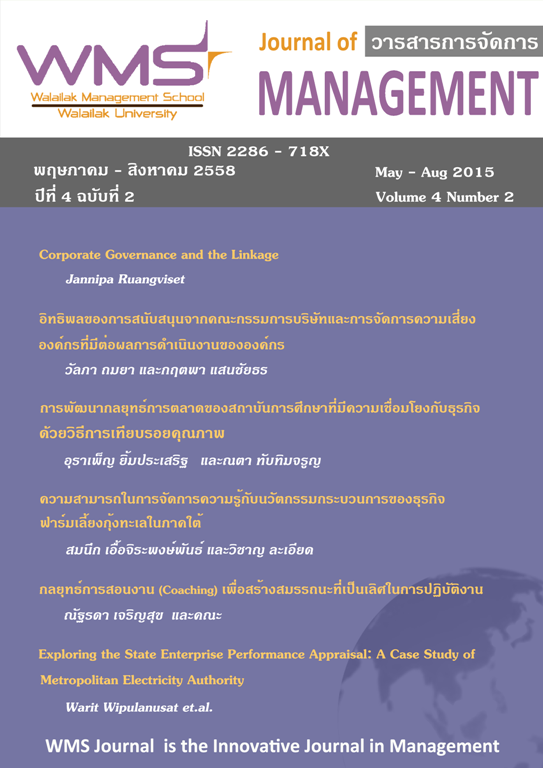Exploring the State Enterprise Performance Appraisal: A Case Study of Metropolitan Electricity Authority
Main Article Content
Abstract
Article Details
References
Baldrige National Quality Program (2005). Getting started. National Institute of Standards and Technology, US Department of Commerce. Retrieved March 22, 2013, From http://www.baldrige.nist.gov.
Bozeman, B. and Kingsley, G. (1998). Risk culture in public and private organizations. Public Administration Review. 58(2). 109-118.
Chiwamit, P., Modell, S. and Yang, C.L. (2014) The societal relevance of management accounting innovations: economic value added and institutional work in the fields of Chinese and Thai state-owned enterprises. Accounting and Business Research. 44(2). 144-180.
Chulajata, I. and Turner, M. (2009). What happens when policies are transferred? The privatization of the telephone organisation of Thailand. International Journal of Asia Pacific Studies. 5(1). 33-53.
Col J.M., Holzer M., Posner P., and Rubin M. (2006). Result-based management in Thailand. Evaluation Report. Bangkok.
Deliz, RJ (1997). Lessons learned from Baldrige winners, Computer industrial Engineering. 33. 171-174.
Denzin, N. (1984). The Research Act. Englewood Cliffs, NJ., Prentice Hall.
European Foundation for Quality Management (2010). EFQM Excellence Award. Retrieved May 6, 2013. From http://www.efqm.org/
Feagin, J., Orum, A. and Sjoberg, G. (1991). A case for case study. Chapel Hill, NC: University of North Carolina Press.
Flynn, BB and Saladin, B (2006). ‘Relevance of Baldrige constructs in an international context: A study of na-tional culture. Journal of Operations Management. 24. 583–603.
Free, C. and Qu, S.Q. (2011). The use of graphics in pro-moting management ideas: an analysis of the bal-anced scorecard, 1992-2010. Journal of Ac-counting & Organizational Change. 7(2). 158-89.
Kantabutra, S. and Rungruang, P. (2013). Perceived vi-sion-based leadership effects on staff satisfaction and commitment at a Thai energy provider. Asia-Pacific Journal of Business Administration. 5(2). 157-178.
Kanulf. B., Berger, R. and Gray, S. (1991). Profile of excellence: Achieving success in the non-profit sector. San Francisco: Jessy-Bass Publishers.
Kaplan, R.S. & Norton, D.P. (2001). Transforming the balanced scorecard from performance measurement to strategic management: part I. Accounting Horizons. 15(1). 87-104.
Kaplan, R.S. and Norton, D.P. (1996). The Balanced Scorecard-Translating Strategy into Action. Boston, MA: Harvard Business School Press.
Khongmalai, O., Tang J. C. S., Siengthai S., (2010), Empirical evidence of corporate governance in Thai state-owned enterprises", Corporate Governance: The International Journal of Business in Society, 10(5). 617 – 634.
Kumar, V., Choisne, F., Grosbois, D. and Kumar, U. (2009). Impact of TQM on company’s performance. International Journal of Quality and Reliability Management. 26(1). 23-37.
Lee, S.M., Rho, B.H. and Lee, S.G. (2003). Impact of Malcolm Baldrige National Quality Award criteria on organizational quality performance. International Journal Production Research. 41(9). 2003–2020.
Merriam, S. (2002). Qualitative research in practice: Examples for discussion and analysis. San Francisco, CA: Jossey-Bass.
Mirsepasi, N., Memarzadeh, G., Najafbeigi, R. and Alizadeh, M. (2013). Model for excellence in the public sector: A Case study of the public organization in Iran. Journal of Basic and Applied Scientific Research. 3(7). 574-583.
National Institute of Standards and Technology (2009). 2009-2010 criteria for performance excellence. Baldrige National Quality Program. Retrieved May 9, 2013. From http://baldrige.nist.gov/
National Quality Institute (2007). Canada Awards for Ex-cellence. Retrieved May 10, 2013. From www.nqi.ca/caeawards/
NPC (2005). Prime Minister’s Quality Award. Retrieved May 12, 2013. From http://dominoapp.npc.org.my/
Office of the Public Sector Development Commission. (2008). The importance and reason of Public Sector Management Quality Award. Manual of Public Sector Management Quality Award 2009 for De-partment in Thailand. Bangkok, Thailand.
Office of the Public Sector Development Commission. (2009). Handbook of Public Sector Quality Management Development. Bangkok, Thailand.
Pun, K. F., Chin, K. S., and Lau H. A. (1999). Self – as-sessment quality management system based on integration of MBNQA/ISO9000/ISO14000. In-ternational Journal of Quality & Reliability Management. 16. 606 – 629.
Pratuckchai, W. and Patanapongse, W. (2012). The study of management control systems in state owned enterprises: A proposed conceptual framework. International Journal of Organizational Innovation. 5 (2). 83-115.
Rodney, M., Renee, R. and Robbie, S. (2002). Sustaining quality in the UK public sector: Quality measurement frameworks. International Journal of Quality & Reli-ability Management. 19 (5). 581-595.
Sila, I. and Ebrahimpour, M. (2003). An examining of quality management in luxury hotels. International Journal of Hospitality and Tourism Administration. 4(2). 33-59.
Sirisampan, T. (2006). Introduction to modern public management. Bangkok: Office Public Development Committee.
Thomas, H., Pollock, T. an analysis: Frameworks and ap-proaches. Academy of Management Executive. 13(1). 70-82.
Union of Japanese Scientists and Engineers (2010). The Deming Prize. Retrieved May 12, 2013. From http://www.juse.or.jp/e/deming/index.html


